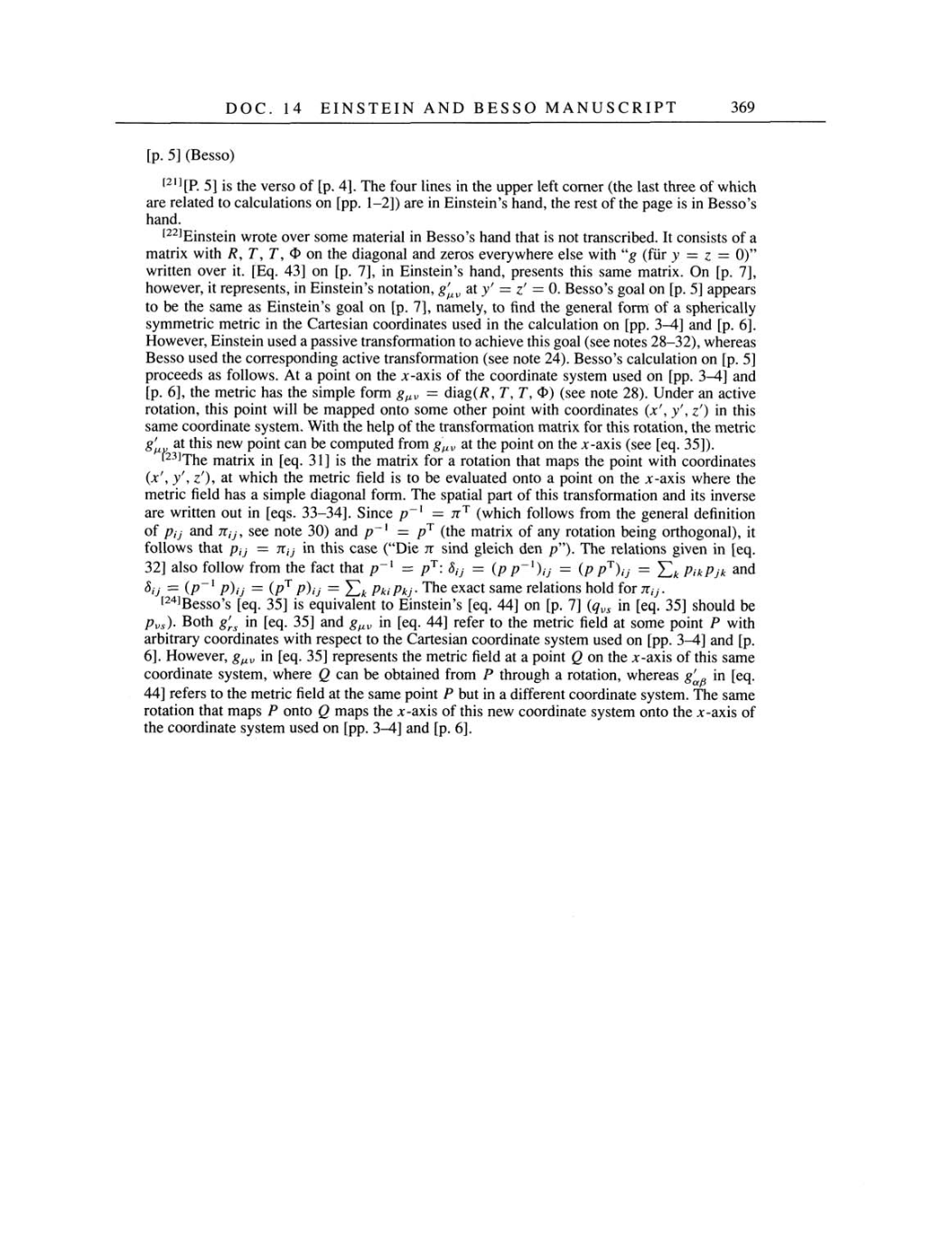DOC. 14
EINSTEIN
AND
BESSO MANUSCRIPT
369
[p.
5]
(Besso)
[21][P.
5]
is
the
verso
of
[p.
4].
The four lines
in
the
upper
left
corner
(the
last three of which
are
related
to
calculations
on [pp.
1-2])
are
in Einstein's
hand,
the
rest
of
the
page
is in
Besso's
hand.
[22]Einstein wrote
over
some
material
in
Besso's hand that
is
not
transcribed. It consists of
a
matrix with
R,
T, T,
$
on
the
diagonal and
zeros everywhere
else
with
"g
(für
y
=
z
=
0)"
written
over
it.
[Eq.
43]
on
[p.
7],
in
Einstein's
hand,
presents
this
same
matrix.
On
[p. 7],
however,
it
represents,
in Einstein's
notation,
g'uv
at
y'
=
z'
=
0.
Besso's
goal on [p.
5] appears
to
be
the
same
as
Einstein's
goal
on
[p.
7],
namely,
to find
the
general
form of
a
spherically
symmetric
metric
in
the Cartesian coordinates used
in the
calculation
on
[pp.
3-4] and
[p. 6].
However,
Einstein used
a passive
transformation
to
achieve
this
goal
(see notes 28-32),
whereas
Besso used the
corresponding
active transformation
(see note
24).
Besso's calculation
on
[p. 5]
proceeds
as
follows. At
a
point
on
the x-axis of the coordinate
system
used
on
[pp.
3-4]
and
[p.
6],
the
metric has the
simple
form
guv
=
diag(R, T, T, Q)
(see note
28).
Under
an
active
rotation,
this
point
will be
mapped
onto
some
other
point
with
coordinates
(x',
y',
z')
in this
same
coordinate
system.
With the
help
of
the
transformation matrix for this
rotation,
the metric
g'uv
at
this
new point can
be
computed
from
guv
at
the
point on
the x-axis
(see
[eq. 35]).
[23]The
matrix
in
[eq. 31]
is
the matrix for
a
rotation that
maps
the
point
with coordinates
(x', y',
z'), at
which the metric
field is
to
be
evaluated
onto
a
point
on
the x-axis where the
metric
field has
a simple
diagonal
form. The
spatial part
of
this
transformation
and its inverse
are
written
out in
[eqs.
33-34].
Since
p-1
=
ttT
(which
follows from the
general
definition
of
pij
and
xij,
see
note 30)
and
p-1
=
pT
(the
matrix of
any
rotation
being orthogonal), it
follows that
pij
=
7ij
in
this
case ("Die
x
sind
gleich
den
p").
The relations
given
in
[eq.
32]
also follow from
the
fact
that
p-1
=
pT:
5ij
=
(p
p-1)ij
=
(p
pT)ij
=
J^k PikPjk
and
Sij =
(p-1
p)ij
=
(pT p)ij
=
J^k
Pki Pkj.
The
exact
same
relations hold
for
xij.
[24]Besso's
[eq.
35]
is
equivalent
to
Einstein's
[eq.
44] on
[p. 7]
(qvs
in
[eq. 35]
should
be
pvs).
Both
g'rs
in
[eq.
35]
and
guv
in
[eq.
44]
refer
to
the
metric
field
at some
point
P with
arbitrary
coordinates with
respect
to
the Cartesian coordinate
system used
on
[pp.
3-4]
and
[p.
6].
However,
guv
in
[eq.
35] represents
the metric
field at
a
point
Q on
the x-axis of
this
same
coordinate
system,
where
Q can
be obtained from P
through a
rotation,
whereas
g'aß
in
[eq.
44]
refers
to
the metric
field
at
the
same point
P
but in
a
different
coordinate
system.
The
same
rotation that
maps
P
onto
Q
maps
the x-axis of
this
new
coordinate
system onto
the x-axis of
the coordinate
system
used
on
[pp.
3-4]
and
[p. 6].
